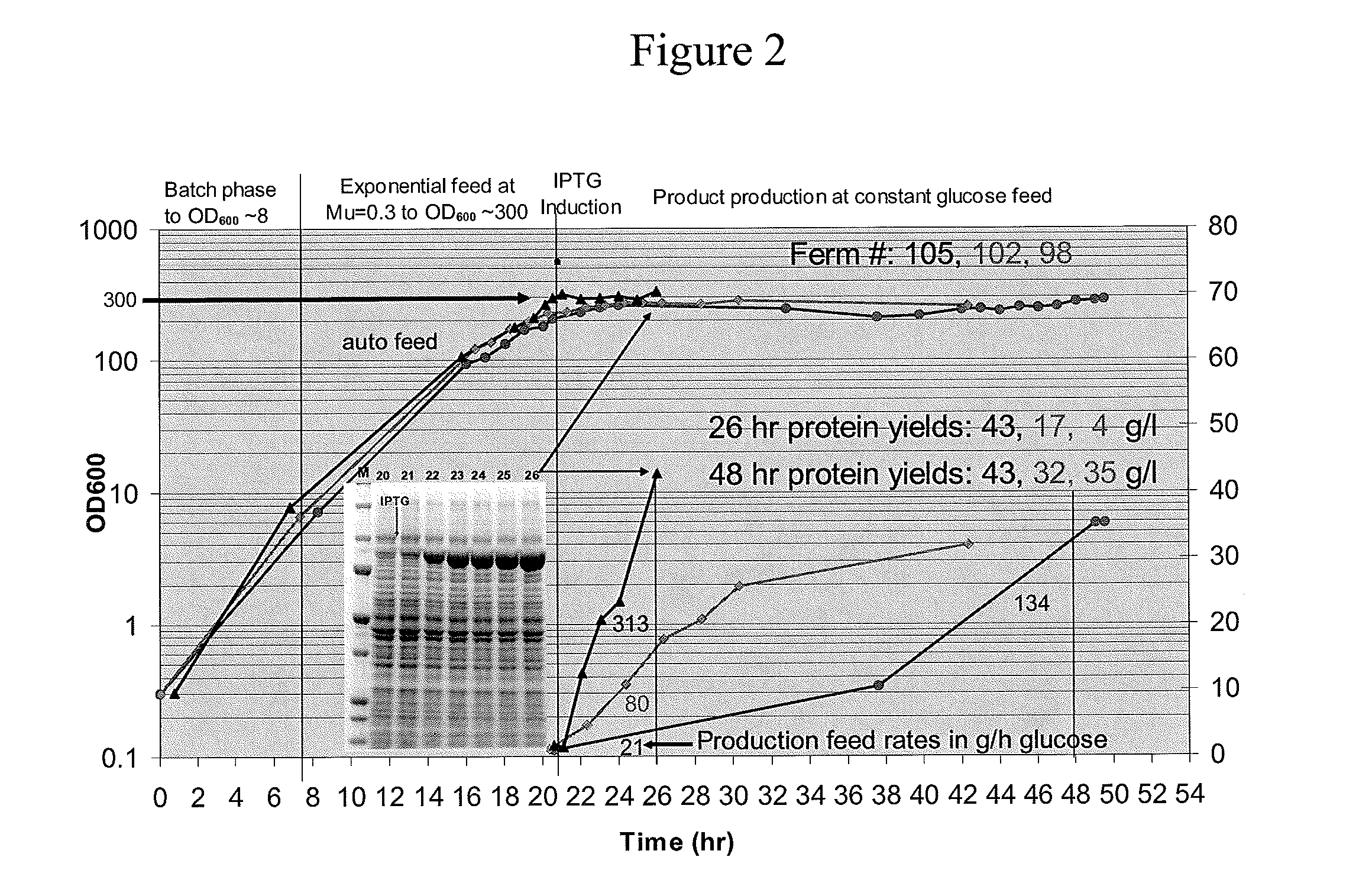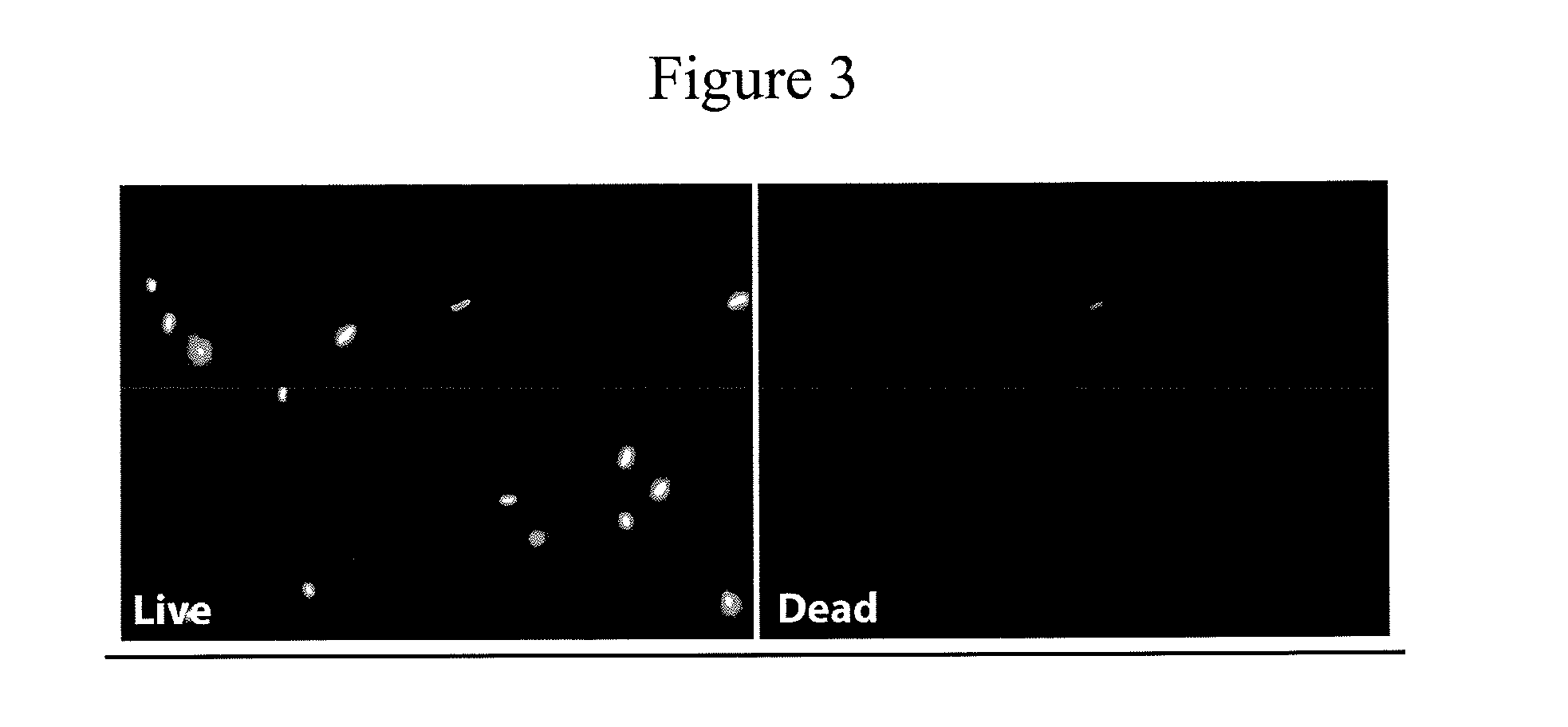Bacteria with improved metabolic capacity
a technology of metabolic capacity and bacteria, applied in the field of genetically modified e. coli k strain derivatives, can solve the problems of limiting the performance and product formation of i>e. coli/i>high density fermentation, difficult to develop, and high cost, so as to improve the production of recombinant proteins and improve growth.
- Summary
- Abstract
- Description
- Claims
- Application Information
AI Technical Summary
Benefits of technology
Problems solved by technology
Method used
Image
Examples
example 1
Production of Modified E. coli K Strains
[0046]The genomic sequence of E. coli K-12 strain MG1655 was compared to that of E. coli B strains BL21 / DE3 and REL606 in order to correlate the phenotypic differences between B strains and K strains to specific genetic features. An alignment of E. coli strain K-12 MG1655 and B strain BL21 / DE3 revealed that 1,415 of the approximately 4,400 genes present in MG1655 are identical. Of the remaining genes, 464 genes contain insertions or deletions, 2,106 genes contain single base changes of which 1,249 result in non-synonymous changes at the amino acid level. The remainder is composed of broken or missing genes, generally clustered within large scale features such as remnant prophage. A similar alignment between K strain MG1655 and B strain REL606 revealed 1,423 identical genes, 472 genes containing insertion or deletions and 2,128 genes with single base changes of which 1,277 result in non-synonymous changes at the amino acid level. To provide per...
example 2
Growth Characteristics of the modified E. coli K Strains
[0056]The effects of each modification on growth and fermentability (i.e. fermentation productivity) were tested separately in MDS42, MDS69, MDS42recA and MDS69recA bacteria. To test the effects of the modifications an objective method for measuring “fermentability” was designed to control for the effects of variables such as inconsistent fermentation conditions and media composition. According to this test, the fermentability of different strains is compared by measuring the maximum optical density (OD) to which the cells can be grown in a standardized fed batch fermentation (in the present case, ten liter fed batch fermentation at 37 C with minimal salts medium (a slightly modified Korz medium with fully-defined minimal salts with trace elements). Glucose was added to the batch phase to 0.5% and the cell growth rate was limited by feeding with glucose at a constant exponential feed rate of 0.3 hr−1 during the fed batch phase....
example 3
Nucleic Acid Production from the Modified E. coli K Strains
[0059]Improved production of nucleic acids is shown in Table 2. Strains MDS42recA (fermentation No. 141) and MDS42 meta recA (fermentation No. 139) were each transformed with a recombinant plasmid gWIZ™ (Genlantis, San Diego, Calif. 92121). Each strain was grown in a ten liter fermenter in minimal media as described above. Cells were harvested and plasmid DNA prepared by alkaline lysis and quantitated by spectrophotometric methods (UV absorbance 260 / 280). Percent
TABLE 1MDS42SG2707SG6265MDS42MDS42 metaDT = 74.4 min; DT = 54.8 min; recA+Mu = 0.56 hr−1 (#701)Mu = 0.76 (#1067) {open oversize brace} LOmutSG6261SG6786MDS42 LoMutMDS42 Meta loMutDT = 77.1 min; DT = 58.0 min; Mu = 0.54 (#1146)Mu = 0.72 (#1143)MDS42SG3100SG6328MDS42 recAMDS42 meta recADT = 75.5 min; DT = 62.5 min; recA−Mu = 0.55 (#822)Mu = 0.67 (#1068) {open oversize brace} LOmutSG6262SG6787MDS42 LoMut recAMDS42 meta LoMut recADT = 83.8 min; Mu = 0.65 (#1141)Mu = 0.50...
PUM
| Property | Measurement | Unit |
|---|---|---|
| induction time | aaaaa | aaaaa |
| nucleic acid | aaaaa | aaaaa |
| density | aaaaa | aaaaa |
Abstract
Description
Claims
Application Information
 Login to View More
Login to View More - R&D
- Intellectual Property
- Life Sciences
- Materials
- Tech Scout
- Unparalleled Data Quality
- Higher Quality Content
- 60% Fewer Hallucinations
Browse by: Latest US Patents, China's latest patents, Technical Efficacy Thesaurus, Application Domain, Technology Topic, Popular Technical Reports.
© 2025 PatSnap. All rights reserved.Legal|Privacy policy|Modern Slavery Act Transparency Statement|Sitemap|About US| Contact US: help@patsnap.com



